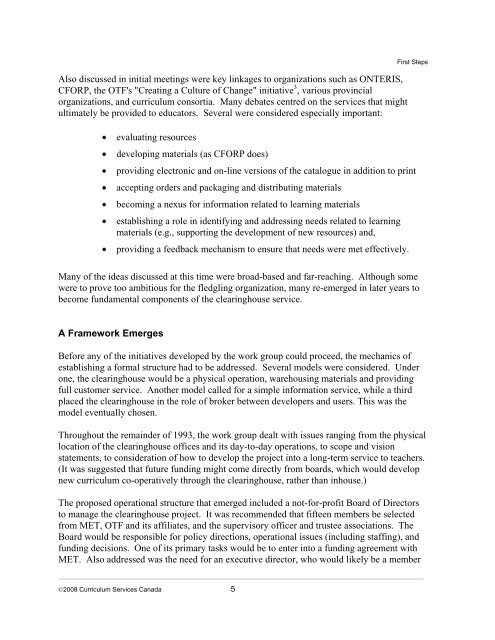a history of curriculum services canada
a history of curriculum services canada
a history of curriculum services canada
You also want an ePaper? Increase the reach of your titles
YUMPU automatically turns print PDFs into web optimized ePapers that Google loves.
Also discussed in initial meetings were key linkages to organizations such as ONTERIS,<br />
CFORP, the OTF's "Creating a Culture <strong>of</strong> Change" initiative 3 , various provincial<br />
organizations, and <strong>curriculum</strong> consortia. Many debates centred on the <strong>services</strong> that might<br />
ultimately be provided to educators. Several were considered especially important:<br />
• evaluating resources<br />
• developing materials (as CFORP does)<br />
First Steps<br />
• providing electronic and on-line versions <strong>of</strong> the catalogue in addition to print<br />
• accepting orders and packaging and distributing materials<br />
• becoming a nexus for information related to learning materials<br />
• establishing a role in identifying and addressing needs related to learning<br />
materials (e.g., supporting the development <strong>of</strong> new resources) and,<br />
• providing a feedback mechanism to ensure that needs were met effectively.<br />
Many <strong>of</strong> the ideas discussed at this time were broad-based and far-reaching. Although some<br />
were to prove too ambitious for the fledgling organization, many re-emerged in later years to<br />
become fundamental components <strong>of</strong> the clearinghouse service.<br />
A Framework Emerges<br />
Before any <strong>of</strong> the initiatives developed by the work group could proceed, the mechanics <strong>of</strong><br />
establishing a formal structure had to be addressed. Several models were considered. Under<br />
one, the clearinghouse would be a physical operation, warehousing materials and providing<br />
full customer service. Another model called for a simple information service, while a third<br />
placed the clearinghouse in the role <strong>of</strong> broker between developers and users. This was the<br />
model eventually chosen.<br />
Throughout the remainder <strong>of</strong> 1993, the work group dealt with issues ranging from the physical<br />
location <strong>of</strong> the clearinghouse <strong>of</strong>fices and its day-to-day operations, to scope and vision<br />
statements, to consideration <strong>of</strong> how to develop the project into a long-term service to teachers.<br />
(It was suggested that future funding might come directly from boards, which would develop<br />
new <strong>curriculum</strong> co-operatively through the clearinghouse, rather than inhouse.)<br />
The proposed operational structure that emerged included a not-for-pr<strong>of</strong>it Board <strong>of</strong> Directors<br />
to manage the clearinghouse project. It was recommended that fifteen members be selected<br />
from MET, OTF and its affiliates, and the supervisory <strong>of</strong>ficer and trustee associations. The<br />
Board would be responsible for policy directions, operational issues (including staffing), and<br />
funding decisions. One <strong>of</strong> its primary tasks would be to enter into a funding agreement with<br />
MET. Also addressed was the need for an executive director, who would likely be a member<br />
©2008 Curriculum Services Canada 5
















